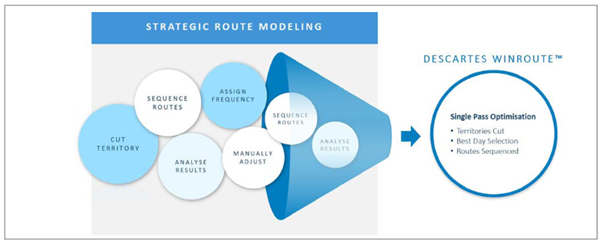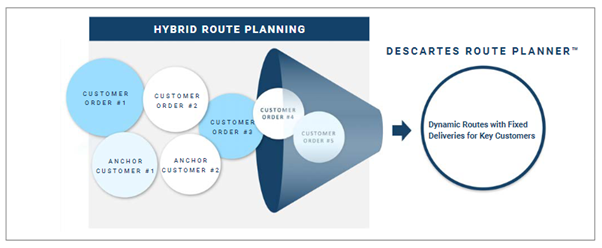Traditional Static & Master Routes Are Too Rigid
Rapid and frequent changes in customer demand caused by the Covid-19 pandemic and changing work patterns has shown that using static or master routes to plan deliveries is no longer the most effective strategy.
While the pandemic has made it abundantly clear that companies needed to be more agile, customer behaviour had been chipping away at the static or master route model for years.
Customer expectations are increasing; they want more flexibility in ordering; their order sizes vary more; and there are more “off schedule orders”.
Coupled with these demands, they still expect greater visibility and a high level of customer service.
The challenge is to balance these new demands while reducing costs.
Static and master routes are not able to keep up with the degree of change, resulting in higher fleet costs, uneven customer service and highly stressed manual efforts to address them.
Covid-19 Forced Companies to Rethink Route Planning
There are three approaches to improve route planning performance:
- incremental improvements, which requires frequent updates to static and master routes;
- a fundamental switch to a dynamic route model; and
- a hybrid approach where the key customers are served through master routes, while less strategically important orders are scheduled dynamically.
Incremental improvement to master routes is a more conservative approach (i.e. less change management) and has its own set of challenges such as how often to re-plan the routes to address changes in customer demand in a cost-effective way.
For many distribution companies, becoming more agile at planning is an impossible task as the traditional process includes multiple steps that take too long, resulting in less frequent updates and new routes that were already outdated.
Moreover, without the proper tools, the quality of the output is heavily dependent on the individual’s judgment and critical thinking skills. This makes it difficult to scale and repeat in a consistent manner.
A more effective and repeatable approach is to use strategic route modelling to quickly create efficient static and master routes that meet customer service requirements.
Dynamic route planning is the best approach to address today’s changing demand and provide the flexibility for tomorrow’s uncertainties.
With dynamic route planning, deliveries are optimised based on actual orders.
No longer constrained by fixed routes or territories, the fleet can be optimally deployed to best serve customers and operate at the lowest cost.
Despite the many benefits available some companies remain reluctant to move to a fully dynamic route planning model
Hybrid route planning provides the benefits of being able to schedule your key customers with regular days, time and or drivers while optimising deliveries for other orders dynamically.
This approach is much more cost effective than static and master routes, and automatically adapts to changes in demand.
More Flexible Route Planning Requires Next Generation Technology
Route planning and optimisation software has changed dramatically over the past few years, and selecting the right solution is critical for transformation and success.
We use different optimisers to solve different problems.
Strategic Route Modelling
Descartes route planning software uses a single pass approach to strategic route modelling, which is a quick and powerful way to reset distribution operations.
Descartes next generation optimisation technology further speeds up the process and produces superior results versus traditional sales and territory planning solutions.
Traditional tools require multiple steps to get to an answer.
First, territories have to be cut, then assign delivery frequencies and delivery days selected and finally sequence routes. In each step, an analysis must be completed to see if that step violated any conditions of the previous step. Also, frequency is a trial-and-error exercise.
With Descartes WinRoute™, all 3 steps occur in a single pass and the optimal frequency is an output, not an input. This approach is much faster and more effective especially for distribution organisations that are trying to be more agile to react to today’s changing demand and need to pivot to new business models.

Hybrid Route Planning
With Descartes Route Planner™, distribution businesses can execute dynamic and hybrid planning in a single solution.
Descartes software has a unique approach to optimisation that allows there to be different customer types with attributes that the optimisation engine uses to best plan routes.
The continuous optimisation capabilities delivered the unique Background Optimiser (BGO) provides the ability to plan orders as they are booked.
Designed to operate in “lights out” mode, planners only have to review the results as they are being planned and focus on exceptions.

Seamless integration with Driver Execution Apps and Customer Notifications
Optimising deliveries is an important first step in reducing costs, improving efficiencies and customer experiences.
Further gains can be realised with fully integrated Descartes Mobile solutions which enable tracking of planned vs actual route performance, eliminate paper-based processes, empower drivers, and improve delivery and data accuracy.
Proactively engaging with your customers throughout their delivery cycle using our fully integrated and powerful Customer Notification technologies completes the delivery experience.
Thriving in the New Normal
Recent events have changed the way we think about supply chains and companies are transforming the way they do business.
Industry leading companies are taking the opportunity to recast their business and make strategic changes by asking themselves these tough questions:
- Are we adjusting master routes fast enough to meet rapidly-changing customer order volume and delivery locations?
- How much productivity will we gain with dynamic route planning?
- Can we use hybrid planning to address key customers and reduce transportation costs?
- How are we integrating our route planning, driver execution and customer notification strategies to deliver on our customer service promise.
Becoming more flexible and productive is key to thriving in the new normal —is your organisation doing enough?
Article published by MHD.